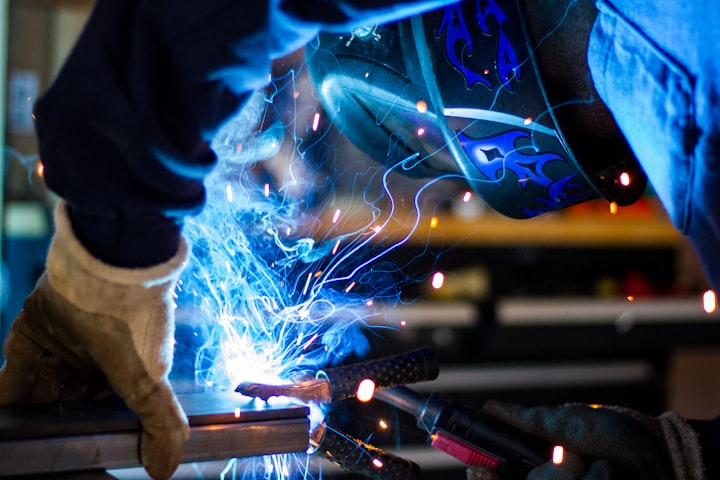The 4th Industrial and Education Revolution: What it Means and How to Respond
Abstract: Each year, the internet connects an increasing number of people and things. This tendency will have a significant impact on our daily lives, as well as how we educate ourselves, connect with one another, and make and distribute commodities. Manufacturing, education, and administration are all going to be affected by the Internet of Things. Because the solutions are all web-based, they can be used together. Many sectors and business models are currently being disrupted by disruptive innovations. Supply chains are impacted by the fourth industrial revolution as a result of increasingly digitized processes and the exponential development of sensible data.

Abstract: Each year, the internet connects an increasing number of people and things. This tendency will have a significant impact on our daily lives, as well as how we educate ourselves, connect with one another, and make and distribute commodities. Manufacturing, education, and administration are all going to be affected by the Internet of Things. Because the solutions are all web-based, they can be used together. Many sectors and business models are currently being disrupted by disruptive innovations. Supply chains are impacted by the fourth industrial revolution as a result of increasingly digitized processes and the exponential development of sensible data.
Strategic management necessitates a clearer understanding of current and interconnected technology and concepts. In addition, associated technologies and concepts are validated in order to determine their contribution to the industrial revolution's future development. Furthermore, because the term "Education 4.0" has a high significance in modern society, it is critical to pass on information and skills to the future generation.
Index Terms - Internet of Things (IoT); Industry 4.0; Education 4.0, MOOC
I. INTRODUCTION
Many aspects of production and administration are about to be affected by the Internet of Things. The fourth industrial revolution, often known as Industry 4.0, is here, and it's replacing old automation's inefficiencies with automatically coordinated automation that uses the Internet of Things (IoT), artificial intelligence, and other technologies. The concept of "blurring the actual world with the technical world" is at the heart of Industry 4.0. Automation, data transmission, and manufacturing technology are all part of this. According to the World Economic Forum, 1 trillion sensors will be connected to the internet by 2022, releasing a flood of data.
The terms "Fourth Industrial Revolution" and "Industry 4.0" have recently become popular in the media. They're talking about the technological revolution, which is expected to "fundamentally transform the way we live, work, and interact with one another." After becoming a hot topic at the World Economic Forum, the notion acquired even more traction (WEF). Professor Klaus Schwab, the WEF's founder and Executive Chairman, first proposed the theory. The main force of this new century, according to Schwab, will be technical transformation.
The fourth industrial revolution, ushered in by the Internet age, necessitates that educational institutions embrace a transformation as well. It's past time for education to move into the twenty-first century. The very least that today's schools need is flexible, tailored curricula taught by teachers who become mentors to their pupils and treat them as people. Giving tomorrow's workers the tools to become active lifelong learners can help to establish a diverse and pluralistic society in which everyone recognizes and plays to their strengths, resulting in a fair and self-sustaining educational model rather than a knowledge-based one.
II. INDUSTRY 4.0
Industry 1.0 (1784): Water and steam power are used to power mechanical production equipment.
Industry 2.0 (1870) was based on mass manufacturing enabled by labor division and the use of electricity.
Industry 3.0 was introduced in 1969, and it was based on the use of electronics and information technology to further automate production.
Today's version of Industry 4.0 is based on the usage of cyber-physical systems.
A. Definition
The Fourth Industrial Revolution, often known as Industry 4.0, looks to be altering how organizations operate and, as a result, the stakes at which they must compete. Organizations must determine how and where to invest in these new technologies, as well as which ones are most likely to suit their requirements. It has the ability to change an organization's processes and operations. The Fourth Industrial Revolution is crucial to comprehend because it affects everyone, not just "manufacturers."
B. Features
● Distributed Intelligence
● Fast Integration and Flexible Configuration
● Virtual Real-Time Representation
● Digital Life-Cycle Management
● Secure Value-Creation Network
● People as Key Players
C. Impacts
Industry 4.0 has an impact on various levels, including entire ecosystems, organizational levels, and individual employee and customer levels.
IoT will have a significant impact on many aspects of manufacturing and administration, including:
● Services and business models
● Reliability and continuous productivity
● IT security
● Machine safety
● Product life cycles
● Industry value chain
● Workers’ education and skills
● Socio-economic factors
D. Advantages
1. Raise global income levels and improve the living conditions of people all around the world.
2. New business prospects will emerge as a result of the new digital factories.
3. Strategy and business models based on data.
4. The demand for skill-based training and skills is increasing.
5. Improved material requirements planning (MRP) models and cloud manufacturing execution technologies provide manufacturers with innovative competitive advantages.
6. Businesses will be able to use these enhanced technical skills as part of Industry 4.0 to boost production while maintaining high quality standards and reducing errors, lowering waste.
7. Industry 4.0 and Internet of Things projects will enable manufacturers to optimize their manufacturing processes through M2M (machine-to-machine) interactions.
8. Furthermore, the manufacturing industry will see a significant reduction in the amount of time spent collecting feedback on products and services.
9. Costs will be reduced, procedures will take less time, productivity will grow, and equipment maintenance will improve.
E. Disadvantages
Many obstacles will be faced in rethinking work flows, technology, and automation, including:
1. Task difficulty.
2. Information accessibility; a general rise in the amount of information available.
3. Demand for travel between branches.
4. Large amounts of complex data that would take much too long for the human intellect to process.
5. An aging workforce and a costly skill transfer
6. The unavoidable assault of information technology and the new generation has resulted in increased inequality, particularly in terms of its ability to disrupt labor markets.
7. It will have an impact on our identity and all of the challenges that come with it, such as our sense of privacy and ownership.
III. EDUCATION 4.0
Four Industrial Revolutions have occurred in the last 250 years, completely altering the face of industry as we know it. Industry changes should and must have a direct impact on how we design education for today's students. Educational paradigms must be rebuilt with each new revolution in society if the goal is to produce students who can become valuable members of the workforce and independent problem solvers.
As a result, Education 4.0 is required, which emphasizes the importance of equipping students to face difficulties head-on. It is an education paradigm that is aligned with future trends, with the goal of developing and improving individualized education that will eventually define how future generations of children will work and live.
The computer, which was invented only 70 years later, ushered in a third industrial revolution. Computing swiftly extended across all industries, from agriculture to finance, management, and shipping, and the rigid procedures of the manufacturing line were suddenly made flexible.
The Internet's pervasiveness brought in the fourth industrial revolution, the Connected Computer, in the year 2000. With the support of the production, shipping, and banking internet industries, remote working and collaboration have become possible, allowing firms to become global enterprises and retail to explode internationally. Society has evolved to be more social and knowledgeable, and many people today believe the world is much smaller than it once was.
A. The Effect on Education
If we look back at how education has changed since the first industrial revolution, we might better understand the challenges for students and teachers today. Students came in with no knowledge. The teacher fed them information on specific subjects, and at the end, the students were tested to evaluate if they remembered what they were taught. This fostered a rigid framework of study disciplines, education standards and eventually standardized testing. Production lines!
The arrival of the computer had no effect on our educational system's basic ethos. Instead, educators simply took advantage of technology and replaced teachers with computers, allowing machines to manage teaching, learning, and assessment.
While the Internet revolution has made long-distance study and access to a great amount of knowledge possible, the framework of our educational system has remained unchanged. The criteria established during the second industrial revolution are currently being used to evaluate learning results. Educators and students are still treated as though they are part of a factory line.
To address this, we need to revisit educational paradigms and focus on the areas that need to be rethought. Students must be trained rather than taught in today's environment of ever changing technologies and information overload. Information must be made available, and students must learn how to discover it rather than the teacher providing it in a predetermined way.
We now recognize that students are not the same, that they do not start from the same place, that they learn and absorb different areas of emphasis in different ways, and that they need to be encouraged to improve their talents rather than being taught a collection of predefined data points. Education 4.0 must integrate with Industry 4.0 in order to adequately educate students for the next industrial revolution, which will occur during their lifetime.
B. Aligning Education 4.0 with Industry 4.0
Classrooms aren't the only place where people can learn. The core notion is expanded upon in Education 4.0. Learning has been made easier in more ways than we could have anticipated thanks to online courses. The introduction of e-learning has been as encouraging and beneficial an experience as one would have hoped for people balancing employment and online courses (to enhance professional growth), or for that matter, those enrolling in special courses given by foreign universities.
The idea of e-learning is pushed to a new level, with people looking for inspiration and more. Education is now seen as a lifelong process rather than a classroom-based ritual, or even a stepping stone to the professional world. Learners and educators will now seek to reimagine how learning has historically influenced their lives.
Education 1.0 began with memorization in the early nineteenth century, while Education 2.0, Internet-enabled learning, was introduced in the mid-19th century. In the twentieth century, education 3.0 focused on both consuming and generating information. Education 4.0 is what we need right now: empowering education to drive innovation.
C. Reason
The big question is why do we need Education 4.0 in the first place. As a result, we've prepared a list of reasons:
1. Students will have additional possibilities to learn at various times and in various locations. e-Learning, e-Library, and other tools help people take advantage of possibilities no matter where they are.
2. Students will gain knowledge through their own study resources. They are free to create their own learning materials based on their capacity and skill. This means that students who struggle in any topic will have extra opportunities to practice until they reach the required levels. As a result, teachers will be able to determine where kids need to improve and will be able to guide them properly.
3. 'Learning by Doing' will be an experience for the students. They will be given several opportunity to practice their abilities in a variety of settings. They will receive sufficient project-based learning, which will aid them in developing organizational, collaborative, and time management skills.
4. Education 4.0 allows students to learn real-world skills that are relevant to their future careers. This means that the curriculum will be structured to allow students more time to complete internships, oversee projects, and work on project-based activities.
5. Students will get the opportunity to develop logical thinking skills. The important part is that they will use their theoretical knowledge of numbers and reasoning to do statistical analysis, examine data, and forecast future patterns.
6. The old means of taking tests are being changed by Education 4.0. Students are not tested on their ability to memorize information. When they work on projects in the field, they are tested in real time based on their performance.
IV. CONCLUSION
Industry 4.0 foretells the start of a new Industrial Revolution, one in which advanced manufacturing and operations techniques are combined with smart digital technologies to create a digital enterprise that is not only interconnected and autonomous, but also capable of communicating, analyzing, and using data to drive more intelligent action in the physical world.
It is characterized by the emergence of capabilities such as robotics, analytic, artificial intelligence, and cognitive technologies, nanotechnology, quantum computing, wearables, the Internet of Things, additive manufacturing, and advanced materials, and it represents the ways in which smart, connected technology will become embedded within organizations, people, and assets.
Around the world, new technologies are enabling an industrial revolution. "Start with little pilots," says the author. Think big, but act small. It all comes down to people and values in the end. We must construct a future that benefits all of us by prioritizing and empowering individuals. We can't predict which scenario will emerge at this time, but history shows that it will most likely be a hybrid of the two.
However, we are certain of one thing: skill, rather than wealth, will be the most important factor in future production. As a result, the job market will become increasingly separated into "low-skill/low-pay" and "high-skill/high-pay" divisions, leading to increased societal conflicts. Governments, technology providers, and manufacturers will need to work together to make Industry 4.0 a success.
Collaboration among three parties would create the necessary physical IT infrastructure, develop shared norms, speed up exemplary projects, and identify R&D priorities. The variables would provide a solid foundation for developing and implementing Industry 4.0 solutions. To make human resources competitive and successful in the fourth industrial revolution, countries will need to rethink educational systems and encourage life-long learning.
V. REFERENCES
P. Angelov, P. (2012). Autonomous Learning Systems: From Data Streams to Knowledge in Real-time
Antsaklis (2014). Goals and Challenges in Cyber-Physical Systems Research Editorial of the Editor in Chief. IEEE Transactions on Automatic Control, 59(12), pp. 3117-3119.
Brettel, M., et al. (2014). How Virtualization, Decentralization and Network Building Change the Manufacturing Landscape: An Industry 4.0 Perspective. International Journal of Mechanical, Aerospace, Industrial and Mechatronics Engineering. 8(1), p. 37.
Broy, M., & Cachon, P. G. (2012). What Is Interesting in Operations Management? Manufacturing & Service Operations Management, 14(2), pp. 166-169.
Dawande, M., Pinedo, M., & Sriskandarajah, C. (2009). Multiple Part-Type Production in Robotic Cells: Equivalence of Two Real-World Models. Manufacturing & Service Operations Management, 11(2), pp. 210-228.
Demetriou, G. A. (2011). Mobile Robotics in Education and Research. INTECH Open Access Publisher, pp. 27-48.
Parlikad, A. K., & McFarlane, D. (2010). Quantifying the impact of AIDC technologies for vehicle component recovery. Computers & Industrial Engineering, 59(2), p. 296-307.
Clark, J. J. (1906). "The Correspondence School—Its Relation to Technical Education and Some of Its Results," Science 24#61, pp. 327–334.
G. Siemens, G. (2005). “Connectivism: A Learning Theory for the Digital Age,” [Online]. Available: http://www.itdl.org/Journal/Jan_05/article01.htm.
McGreal & Siemens, G. (2012). “Openness in Education,” 10-Sep-2012. [Online]. Available: http://open.mooc.ca.
This story is also published in Academia.
Here's the link below
About the Creator
Domingo Añasco-Gaces Samontina, Jr.
.Professional Member of the Mechatronics and Robotics Society of the Philippines
.Certified Documented Information Controller with TUV Rheinland Qualifications
.Master of Science in Engineering (on-going) with Professional Teacher Certificate






Comments (1)
I find that getting an education has become easier in recent times thanks to the emergence of sites like chromatopia https://chromatopia.org/best-legit-essay-writing-services/ where you can find best legit essay writing services. Personally, writing an essay is difficult for me, and I don't want to waste my time and energy on an essay. It's better to find specialists.